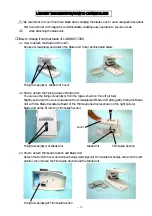
13
3.1.1.3 Locking unit
First of all, the guide sleeve of the locking unit is inserted
in the spindle. Attention should be paid to the careful in-
sertion of the O-ring on the guide sleeve into the spindle
drill hole in order to avoid the shearing of the O-ring.
The module with clamping sleeve, collet and draw bar
is screwed into the spindle from the front. The movable,
protuding collet in the clamping sleeve is initially positi-
oned over the pull bolt without any screwing movement.
The collet is then manually placed on the head of the
draw bolt, the clamping sleeve is repositioned on the
collet as far as it will go on the rotation prevention screw
and is then pushed axial onto the draw bolt (compare
illustration 6) with some pressure. Depending upon
the HSK nominal size, this process is undertaken with
some application of force due to the spread of the collet.
Standard tools can be used as aids.
3.1.1.4 HSK clamping set
Once the clamping sleeve has been successfully
mounted, the HSK clamping set can be installed. The
assembly and setting regulations for HSK clamping sets
must also be observed.
In order to determine the necessary position of the
pressure head in the release position, the calibrating
disc included in the delivery must be cut to the neces-
sary size. In order to do this, the pressure head with
a calibrating disc is screwed to the drae bar and the
resulting is measured.
The thickness of the calibrating disc is then reduced
by the difference between the existing amount and the
stipulated amount. The pressure head underlaid with
the adapted calibrating disc is countered on the draw
bar (compare the setting measurement in the assembly
drawings).
Warning: the tolerance range for the setting
measurement may not be exceeded! During
start-up operations, proceed with particular care
in order not to damage the threaded pins of the
rotation prevention on the collet. The position of
the draw bolt described in point 3.1.1.2 must also
be observed.
Once the HSK clamping set is mounted, the full system
with the locking unit and clamping and release unit is
now ready for use.
3.1.2 Mounting aids
The locking unit can be installed with standard mounting
tools. Special keys are only required for mounting the
clamping sleeve. Standard torque keys can be used
on the special keys (refer to table 3 for Röhm ID no) to
apply the right torque level.
3.2 Initialisation
The functions of the locking unit can be checked by
operating the clamping and release unit when the
spindle is stationary.
The “tool released“, “tool clam-
ped” and “clamped without tool” positions are determi-
ned (refer to table 1 for values). An HSK testing tool with
“0 position” on the HSK clamping shoulder is used to
determine the exact clamping position.
In order to determine the positions of the various opera-
ting positions, the relevant sensors must be tuned to the
clamp strokes and signal ranges in the machine control
must be recorded.
3.2.1 “Tool released” position
This position is checked when mounting the full system
(refer to 3.1).
3.2.2 „Tool clamped“ position
Due to the tolerances of the HSK tools, the tolerances
of further elements in the force flow and the flat angle in
the locking unit results in a relatively wide clamping ran-
ge around the ideal clamping point (nominal clamping
stroke on the draw bolt). Table 1 contains these values for
all HSK sizes (stroke range on the draw bolt: e.g. 16-4
mm for HSK63).
Analogue sensors are generally used to establish the
stroke range. The sensor must be coupled with the ma-
chine controls in such a way that the necessary “clamping
window” for the “clamping tool” function is identified and so
that the spindle shuts down if changes to the axial clam-
ping position take place during rotation.
3.2.3 „Clamping without tool“ position
The maximum value of the clamping position can be
exceeded as long as it is ensured that the clearance to the
“clamping without tool” position does not lead to malfunc-
tions. Depending upon the nominal size, it is recommen-
ded that a minimum clearance of 1- mm is maintained
between “clamping” and “clamping without tool”. This also
applies to special applications. Table 1 contains the maxi-
mum values of strokes for clamping without a tool.
3.2.4 Sensor technology for determining the position
In order to establish the positions described above, sui-
table sensor technology which is linked with the machine
controls must be used. If these modules, as a part of the
clamping and release units, are not purchased from Röhm,
the monitoring functions described above must be imple-
mented in a sufficient manner.
The monitoring of the clamping position of the
locking unit during processing is necessary from
a safety point of view. If the operator of the locking
unit does not monitor the clamping position, Röhm
expressly refuses any liability for possible da-
mages caused by malfunction of the locking unit.
Montage- und Betriebsanleitung für
Fremdsprachentexte ...
Handspannfutter (Keilstangenprinzip)
Fremdsprachentexte ...
Fremdsprachentexte ...
mit Backensicherung
DURO-T
E
F
RUSS
Summary of Contents for SuperLock HSK Series
Page 15: ......


































